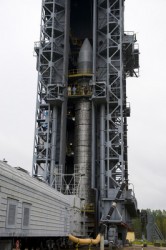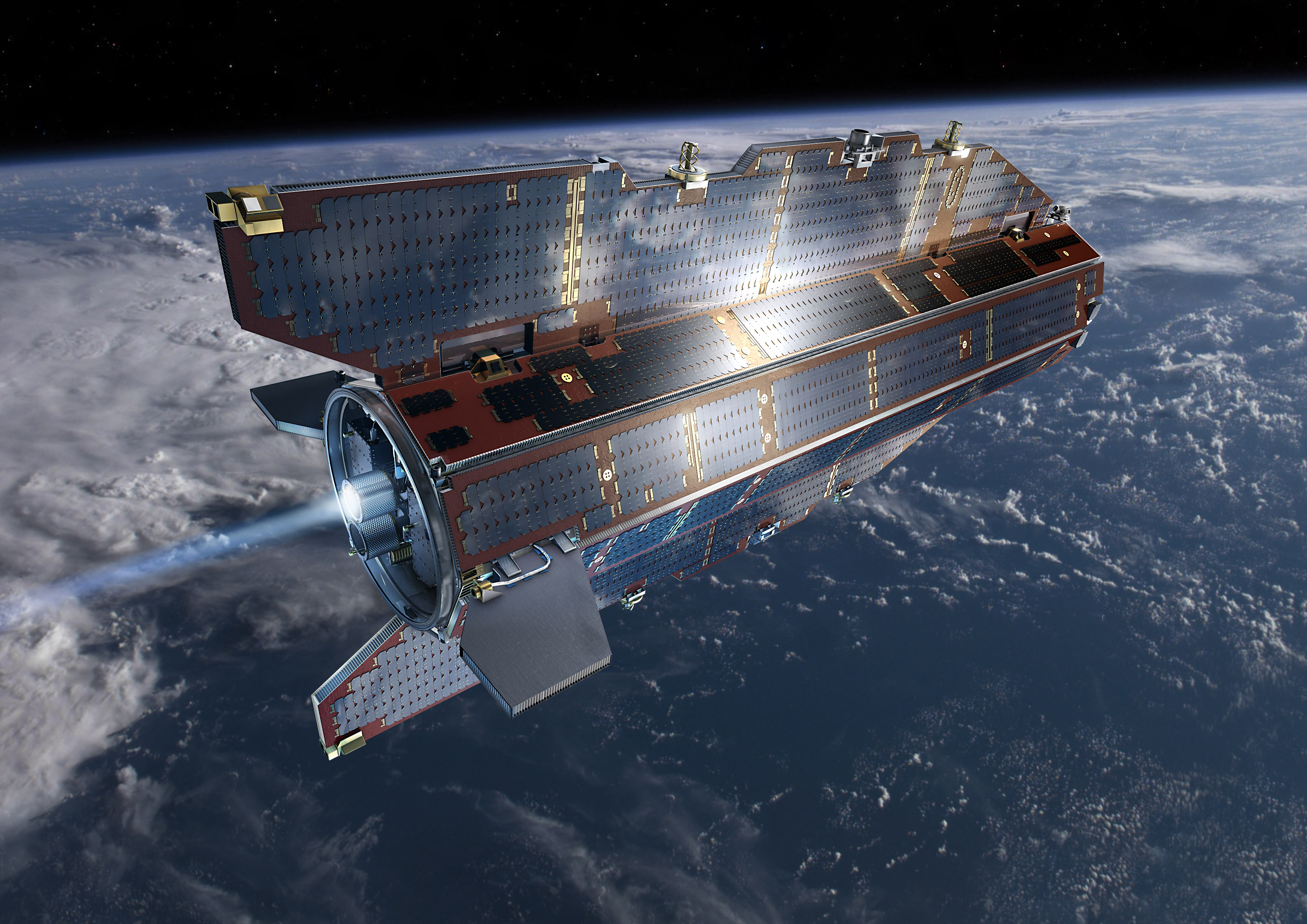[/caption]
This has to be the sexiest looking spacecraft ever built by humankind. No, it’s not a starship or battle cruiser (although it does look a little like the Eagle spacecraft from the old television show Space: 1999). This sleek, slender, sexy, shiny and sophisticated spacecraft is an Earth-orbiting satellite that will investigate our planet’s gravitational field and map the reference shape of our planet – the geoid – with unprecedented resolution and accuracy. GOCE, or the Gravity field and steady-state Ocean Circulation Explorer is scheduled to launch on Wed. September 10 at 16:21 CEST (14:21 UTC). Why such a sleek design? As GOCE Systems Manager Michael Fehringer says, “Form follows function not only in the world of fashion! To fly low and avoid air drag, the best shape for the satellite to be is long, slender and absolutely symmetrical along the direction of flight.”
ESA’s 1 ton, 5 meter-long spacecraft will be in an extra low orbit (260 km, or 161 miles) and will experience drag from Earth’s upper atmosphere, so smooth and lean helps reduce the friction. Adding to the sleek design is that the solar panels are attached to the long body of the satellite instead of sticking out clumsily and adding to the drag. ESA has a great animation of GOCE in flight. Although the design will help, the spacecraft will need a boost to its orbit occasionally, and has state of the art ion engines.

GOCE will be in a sun-synchronous orbit, meaning it will be almost always be in sunlight, providing a stable thermal environment for the spacecraft.
The instruments are all placed along the axis of the satellite’s body, adding to its sleekness — check out this great animation. GOCE carries a set of six state-of-the-art high-sensitivity accelerometers to measure the components of the gravity field along all three axes. The data collected will provide a high-resolution map of the geoid and of gravitational anomalies. This will greatly improve our knowledge and understanding of the Earth’s internal structure, and will be used as a much-improved reference for ocean and climate studies, including sea-level changes, oceanic circulation and ice caps dynamics survey. Numerous applications are expected in climatology, oceanography and geophysics, as well as for geodetic and positioning activities.
Here’s an interactive feature to take a closer look at the spacecraft.
Oooo. It’s enough to make a girl purr.
Source: ESA
Also, check out Ian’s article on Astroengine


Well, awesome, yes, but “sexy”? …
that’s hot…lol
Is it not kinda odd that the ESA is launching GOCE to study Earth’s Gravity field exactly the same day C.E.R.N. is turning on the L.H.C.? “Beware the 10th of september when Particales and Gravity Will be Bender”
Well it is phallic shaped 😉
Since it has an engine, I wonder if it could gain enough velocity to escape earth’s orbit? If so, then could it be considered a “probe” instead of a mere satellite?
Besides, the idea that a “probe” could be sexy makes me LOL
LOL!
That’d be our European charm at work, Nancy 🙂
@ Jorge –
I’m sure that’s it!
Nancy
Perhaps Europe is compensating for a small… errr… sorry, just realized this was out loud.
“GOCE will be in a sun-synchronous orbit, meaning it will be almost always be in sunlight, providing a stable thermal environment for the spacecraft.”
just out of curiousity, does anyone know what sort of temperature we are talking about?
OK, if you think this is sexy, you have to get out more! 🙂
Dave,
Sun sync orbit doesn’t mean it will always be in sunlight (it will be in it about half the time). It means it will be in the same location, each day at a specific time; ie. it will be over Dallas, TX every day at 15:00 hours.
Think of the orbit where an object travels through one time zone an orbit, and gets through all of them in 24 hours or 24 orbits.
I still think ESA is checking to see if there’s anything funky happening to the gravitational field around C.E.R.N once L.H.C. is turned on. I am self admittedly an neophyte when it comes to this stuff, but my intuition is telling me something is up.
Love this website
Scott
Actually, them launching it the same day means there’s nothing wrong. no such satellite will work reliably from day one. See Fermi/GLAST, tokk them weeks to get it running and calibrate it.
That is arguably one of the coolest looking space craft human kind has launched.
I’m afraid it might get carjacked by space hoodlums.
Best of luck to you,sexy.
cool…yes
sexy…for a sat? Yes
Looks like the Space:1999 Eagle…not even close!
But still a cool looking bird!